Earthship Biotecture Transcribed: Session 2 - Part 4: Botanical Cells, Using Water 4 Times, Food Production.
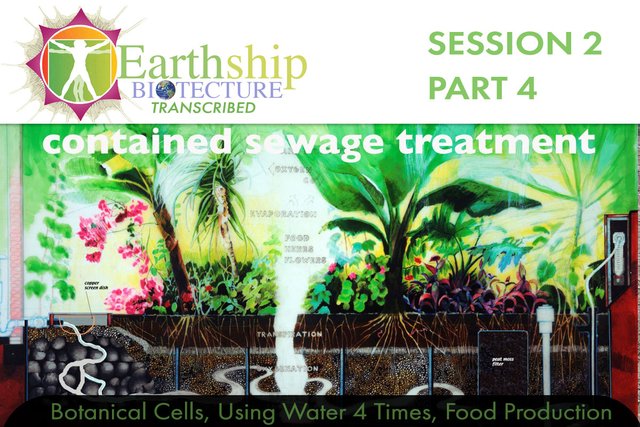
I would like to thank Mike Reynolds for giving me permission to transcribe, edit and reformat this work for the Steem Blockchain! If you do read or watch this and have any questions please ask in the comments. I am happy to educate and help you to understand this. Biotecture is amazing in so many ways, and even after 20 years I still have not seen a model of sustainable building that even comes close in so many important areas such as performance, carbon footprint, longevity, ease of build, etc... Now you can also come to understand what Biotecture Really Is about!
Commentary
Reusing water up to 4 times is one of the very special features of earthships. There are quite a few very important benefits to reusing water and we go through many of them here. Being able to use a flush toilet using second had shower water (grey water) is a sensible thing to do, many people don't want to have to deal with composting toilets. Food production is a second very important use, and you can grow an abundance of fruits and vegetables without even having to water them. All you have to do is clean your dishes!
In this part we take a detailed look at the Botanical Cell and how it has evolved over the years. Mike explains the old methods, that have evolved into the new, no maintenance options. It is important to understand how botanical cells work and how they have evolved. This is because you can then design them with your own ideas and materials you have to hand. There are many ways to do this, and whilst building Earthship Karuna I found my own ways to deal with using planters that use kitchen water as well as shower water. Using kitchen sink water was abandoned by Mike because they used to trap all the grease and junk using filters that were nasty to clean. What I did was to use a bypass system so that when I wash things that are greasy, or with too much soap, i let that water shunt outside to some bananas trees. When i want to fill my planters I then switch two valves so that my dish water then dumps directly into my botanical cell. It works!
Making these botanic cells is a lot of fun and you can be very creative with them. The walls of these planter cells can be made from bottles and cans, with mud and cob.. so they can be very cheap if not free to build!.
Earthship Seminar Transcription Session 2 -
Part 4:
Botanical Cells, Using Water 4 Times, Food Production
So water systems are all about how you encounter the rain and the snow, to get water coming out your faucet hot and cold and drinking. So then connected with that is then the sewage... the major component of that is this thing right here that we call a botanical cell. The newer drawings of this are a little more evolved... but what a botanical cell is it's a it's even... that one back there is early... everything in this building is early... but it's a rubber lined cell about three feet deep. It can be any length we usually make the links relative to how much how long the rubber comes... so that you can don't have to you don't want to have to splice... it but the botanical cell is usually sometimes we have them in the first part of the building on behind the first layer of glass, and then we have them in the greenhouse of course... and then we have them outside. You can see one under construction outside at the Sutton house that Kirsten's going to take you to.
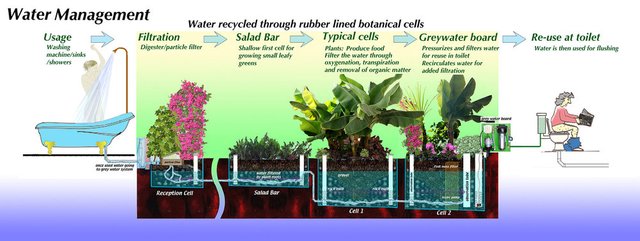
IMAGE SOURCE
Basically your water is going through these rubber line cells full of plants. The whole issue there is that plants clean up the water. The way they clean up the water... there's a bacteria... First of all the botanical cell as you can see is is full of gravel for two and a half feet... then there's a little layer of sand or straw or both... the purpose of that is to keep the dirt from falling down into the gravel, because the gravel, the voids in the gravel, create a body of water that the plant... it's like hydroponics almost.. that the plants always have access to a thousand gallons of water. The dirt is just to structure the plants because they're getting their nutrients from the gray water... and you know some of it from the dirt... but mainly from the gray water.
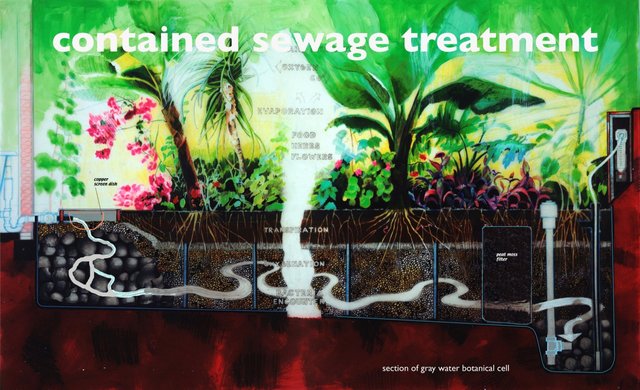
IMAGE SOURCE & READ MORE
This drawing was made just from slicing into one of these botanical cells and seeing what it looked like (see above image). The big rocks are what we call reception in and reception bulbs because that creates bigger voids of water... so that for instance when your bathtub drains it's going to drain slow if it goes straight into the gravel. But if it if you have the big rocks they're sized so that a whole bathtub can drain fast into the voids between the rocks and then it moves through the gravel.
But it starts with the water going into a device very similar to like the silt catch on your roof. You have to deal with the fact that out of your shower there's hair and soap and whatever... and in your kitchen sink there's all kinds of stuff... bacon bits and broccoli pieces and whatever... So we used to see we keep evolving.. we used to want every drop of water to go through the botanical cells, and then we recapture it at the end to flush with. What's going on in the Botanical cell is in the gravel there's a bacteria that come naturally, that kind of attacked the water and clean it up a bit... but the main thing that's going on is as the plant roots suck up the water... which they do... they put out oxygen. Their plant roots are just tubes and they're they're sucking up water... probably through a natural convection like we're sucking up air in the buildings... and as they suck up water they have to evacuate oxygen, the oxygen oxygenates the water... it's what cleans it up... it's called oxygenation... that's what cleans up the water and then there's a certain transpiration and evaporation aspect... but that thousand gallons of water is moving through the Botanical cell, getting sucked up by the plants... getting oxygenated... then it runs through a peat moss filter at the very end... and then it drops in to a lower place... full of big rocks again... there's submersible pump that's down there that's set up on a pressure switch, so that whenever you flush your toilet the water comes on and that pump comes on. It's another little pump panel up there on the right... whenever you flush your toilet the the float valve in the toilet opens up a plumbing valve, which turns on the pump and pumps gray used oxygenated gray water into your toilet until it fills up and then it stops.
So that's what goes on with this system and then the toilet goes on out to a conventional septic tank... and I'll get into that... it's still contained. I'll get into that aspect of it but there's gray, and there's black which is the toilet. What I was getting at is that the kitchen sink it's kind of borderline, because it has solids and pieces and parts in it. We used to always run the kitchen sink into here because there's a balance... in other words, your daily activities have to produce enough water to deal with the volume of flushing that you do. So we would run all the water into there here except for the toilet..
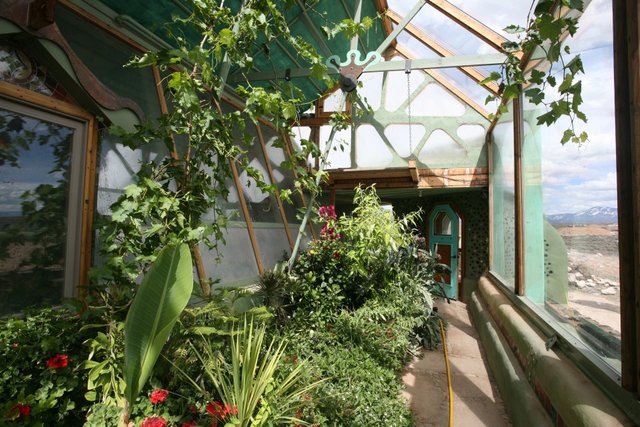
IMAGE SOURCE
But we found out that basically a home is balanced by the washing the clothes, washing machine, the sinks where you brush your teeth and wash, and the shower. Those activities produce enough water to give you enough to flush, with you don't need the kitchen sink. But we didn't know that for the first few years, so we had we made these devices. There was a little tray to catch grease this is called a grease and particle filter, a lot of the houses used to have them. I don't think any of the new ones have it anymore because now we take the kitchen sink, we consider it black water, take it to the to the septic tank with the toilet and deal with it that way. We still get enough water to flush with the only out of balance thing about this is like a situation like here today. You guys are all using the toilet but none of you are taking showers... so you're depleting our flushing water by not taking showers. So on the break everybody should go in there and take your shower... but help yourself... We're sure yeah ...solar hot water ...help yourself ! Otherwise Michelle has to go in there and stick hose down the pipe and and replenish the flushing water for you all to flush with.
So in a normal home with two or three people living in it they're taking enough showers to equate to their flushing... and there's a balance there and we've gotten that together over the years... but we didn't have it together in the beginning. So see if you if you're just filtering or silt catching your bath water and your clothes washing water all it is is a little copper tray with holes in it that catches the hair and whatever take it out every month or two and tamping on a compost pile and be done with it, but when your kitchen sink ran into here it was a grease and particle filter situation. It was a much more elaborate device and that's a picture of it right there. What you'd have to do is is you'd go in and take that tray out but it'd have bacon and hair and broccoli and grease and all kinds of stuff... it was pretty gnarly, and people talk... and so on-line we'd hear people talking about what a nasty job cleaning up cleaning out and servicing an Earthship grease and particle filter was. Well we've eliminated that now because we don't use them anymore because we run the kitchen sink in with the toilet... but it got so gnarly that we started going okay will will respond to the people's complaints. And see that little inlet line that little black inlet line right... there taking all the stuff comes out of that and collects in that tray... and that tray gets pretty gunky.
So we got the brilliant idea of taking a woman's hose and radiator clamp, and we'd clamp it so the pipe comes in like this and all that stuff that was going into this little tray. Well we just realy clamped a woman's stocking over there... and every couple of months that stocking would get full... and be this big chunk of stuff... slimy thing laying there... looking sort of alive. And whenever your tub quit draining properly we'd know that the the stocking needs to be changed, and so I had a maintenance guy that used to do that all the time and and I knew if he wasn't around... if the people came to us and said... "it's not draining properly why?" I would know what to do and I did it sometimes... and one at a time we had one of these grease and particle filters right under the kitchen sink in a hut house, which is not online as a nightly rental anymore. It's a nice little building but it's out of date. So underneath the kitchen sink doors, you'd open the doors and there's the grease and particle filter where the Redwood lid... and you open the lid... and so anyway this guy, the maintenance guy, threw me a curb. He didn't just get a single woman's hose on there, he got pantyhose..he put the full panty hose on there. And so after about three months the hut house quit draining properly, so he wasn't around so I went in I knew exactly what to do... I open the kitchen cabinet doors popped off the Redwood lid and these two legs... slimy came slamming out and hit me in the face... and just gunk all over me and everything... so that was really the inspiration for moving forward from that design, but it hasn't all been easy.
Well here it doesn't matter, your flushing your toilet because you're flushing it with used water it just changes the whole concept. We don't even care if you have a low flush toilet or not.
So just you know that would definitely get written about online, so we don't even use them anymore. Now we just have a little copper tray, it catches the hair from the bathtub. The kitchen sink is plumbed to go with the toilet to the septic tank, and we have found out that that's enough. People take enough showers and wash enough clothes, and brush their teeth enough, to create enough flushing water... and you know in water conservation they're always talking about don't flush your toilet any more than you have to. Well here it doesn't matter, your flushing your toilet because you're flushing it with used water it just changes the whole concept. We don't even care if you have a low flush toilet or not.
So of course all the toilets are low flush these days I think. But this is just the kind of evolution. Like we used to go... that's a little redwood cage for the for the charcoal and peat moss filter... Now we have the charcoal filter on the water board, and it's just a peat moss filter. And still we used to make a little redwood cage, and take a guy a day to make it, and and put the peat moss in it and all that. And that's evolved because now our botanical cell is linear and it's about two feet wide and 25 feet long or so... And the gravel is all in here and everything. Well we get a peat moss Bale, they come in plastic bales, and we just cram it... we just take an ice-pic and stab it a bunch of times... cram it into the space, and the water has to go through it.
In other words we're just constantly getting the methods of doing this more and more simple more and more straightforward and work better so we haven't had much problem with gray water at all in recent history. The corner cottage,,, we hit rock, and those botanical cells had to go laced up and down over rock and everything... and sometimes the water there doesn't move fast enough to the flushing well... and we have to run the bathtub to do in that one. The Phoenix has got huge gray water planners it rarely if ever runs out of flushing water... and it definitely this system to the to the limits...
But anyway you have a botanical cell. You can put them in tandem, link them together. You'll see them in every building inside the living spaces and in the greenhouse. Clearly they have to be on the solar gain side of the house so they get Sun... Because the plants growing is what sucks up the water... and so basically they're the first use of the water is taking a shower. The second use of the water is growing food aloe vera grapes bananas whatever... and then third use is flushing your toilet. the fourth use is landscaping which I'll get into later.
So we have taken these botanical cells now way far into food production. The way that this evolved... just like with the stockings... before we invented all this stuff we were not going to make earthships use flush toilets. We use compost toilets which... they work fine but the ninety percent of the people, they want it to go away... they don't want to be dealing with it,you know whatever... although compost is a great thing lots of people don't want to deal with it. So we were still adamant about it, we were going to use compost toilets because we didn't want to flush away even at gallon and a half, back in those days it was five gallons of water, fresh good new water, especially if you're harvesting it from the sky. You can't afford to.
Water is used in a conventional way such as bathing or washing dishes, except for the toilet. The water is used and cleaned a second time in interior botanical cells. The flush toilet is the third use of the water. After the toilet, the water is contained and treated, and used a fourth time in exterior botanical cells.
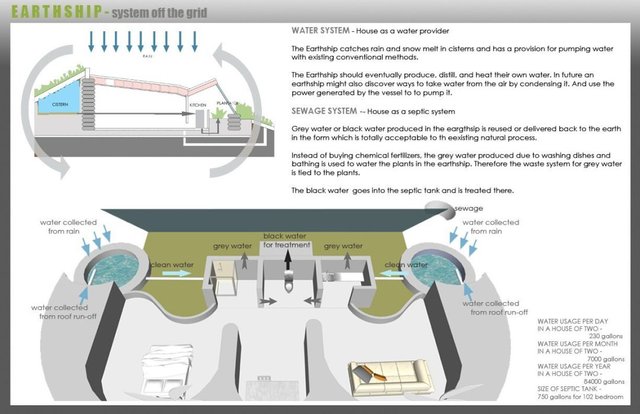
IMAGE SOURCE

Earthship Seminar Video 2009 - Session 2 -Part 4

READ PREVIOUS TRANSCRIPTS
SESSION 1
Part 1: The Global Model
https://steemit.com/ecotrain/@eco-alex/earthship-biotecture-101-learn-with-michael-reynolds-part-1
Part 2: Staying Cool: The Convection Engine
https://steempeak.com/ecotrain/@eco-alex/earthship-biotecture-transcribed-seminar-with-michael-reynolds-transcribed-part-2
Part 3: The Evolution of the Global Model Earthship:
https://steempeak.com/ecotrain/@eco-alex/earthship-biotecture-transcribed-seminar-with-michael-reynolds-part-3
Part 4: Heating your home with body heat in Norway, about permits in USA and Europe... How to get them fast
https://steempeak.com/ecotrain/@eco-alex/earthship-biotecture-transcribed-pt4-heating-your-home-with-body-heat-in-norway-about-permits-in-usa-and-europe-how-to-get-them
Part 5: How to Retrofit, Getting Permits, Tire Toxicity?
https://steempeak.com/ecotrain/@eco-alex/earthship-biotecture-transcribed-pt-5-how-to-retrofit-getting-permits-tire-toxicity
Part 6: Bottle / Can Walls, Tyre Foundations / Snow Water
https://steempeak.com/ecotrain/@eco-alex/earthship-biotecture-transcribed-pt-6-q-and-a-bottle-can-walls-tyre-foundations-snow-water
Part 7:&: Can you insure an earthship?, the double/triple greenhouse, the global model evolution + more
https://steempeak.com/ecotrain/@eco-alex/earthship-biotecture-transcribed-pt-7-q-and-a-can-you-insure-an-earthship-the-double-triple-greenhouse-the-global-model
Part 8: Final: Year round fruiting trees, sizing greenhouses + more
https://steempeak.com/ecotrain/@eco-alex/earthship-biotecture-transcribed-pt-8-final-q-and-a-year-round-fruiting-trees-sizing-greenhouses-more
SESSION 2
Part 1: Water, how to size your roof, choosing the right materials for water catchment.
https://steempeak.com/ecotrain/@eco-alex/earthship-biotecture-transcribed-session-2-part-1-water-how-to-size-your-roof-choosing-the-right-materials-for-water-catchment
Part 2: Cisterns, Filtering Water, Designing Down & Layered Thinking.
https://steempeak.com/ecotrain/@eco-alex/earthship-biotecture-transcribed-session-2-part-2-cisterns-filtering-water-designing-down-and-layered-thinking
Part 3: Water! Be Self Sufficient Secure & Sustainable
https://steempeak.com/ecotrain/@eco-alex/earthship-biotecture-transcribed-session-2-part-3-water-be-self-sufficient-secure-and-sustainable

Did you know, I built four Earthships in India as well as being instrumental the creation of the first Earthship in the UK, Earthship Brighton. If you are also on this path and would like to read my story, I have recently published a book. It is not only a great story, but a valuable resource for you to learn from. I had no experience or training when I embarked on my mission, but managed to successfully build a gorgeous home called Earthship Karuna.
You can buy this book with Steem on the homesteaders co-op. Whilst you are there please do have a look at some of the other products as there are all kinds of great things there!

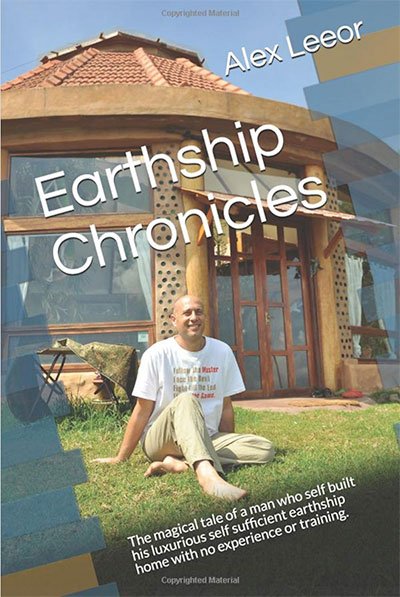
https://homesteaderscoop.com/product/earthship-chronicles-ebook/
If you don't have any Steem you can also buy the ebook and paperback on amazon.
http://mybook.to/Earthship-Chronicles
or
https://www.amazon.com/Earthship-Chronicles-sufficient-luxurious-experience-ebook/dp/B07MYCBXYB
@ecoTrain
Supporting People Who Help
Make The World A Better Place

Discover previous ecoTrain magazines at @ecoTrain
** Click Here To View Our Passenger Feed**


You preset such interesting shit, my dear. LOL. Literally sometimes. Our western heads need to rethink toilets and flushing and waste water - period. Doing that in a lovely Earthship?? Sounds like a win for Mother Earth and Us, to me!!
Leading the curation trail for both @ecotrain & @eco-alex.
Together We’re Making This World A Better Place.
Click Here To Join the manually curated trail "@artemislives" to support quality eco-green content.
@ecoTrain
this is indeed the epitome of interesting shit! thank you!